No injury or person is identical. So anytime we have an injury, we need to treat it uniquely. That being said, there are some general tools that can help. This post will offer some tools to get started if you ever sprain your foot. A sprain is a stretching or tearing of a ligament. A strain is a stretching or tearing of a muscle or a tendon. But it is always recommended that you talk to your doctor. You want to make sure you are dealing with a sprain and not something else.
Tools for Healing
• Experiment with ice or heat. Ice will help reduce inflammation, but heat will help bring blood to the area, which will promote healing. If one seems to cause aggravation, try the other. I’m a lover of ice—the sooner the better and multiple times throughout the day.
• Massage the area. Immediately upon spraining something, a specific area may be tender to the touch. Do not feel like you have to rub that area, but try to massage as close the area in pain as possible without causing pain. You can rub the sole of the foot or the ankle. Never create pain, but rub what you can. If it feels good you can take a small ball (the firmer the more tender it will feel) and roll your foot back and forth over the ball.
• Micromovements are a great tool to retain mobility. Very small movements can help keep mobility. This can be exploratory as every sprain is different. Try pointing and flexing the foot as much as you can. Or try small ankle circles? Can you spread your toes? If it hurts, do not force it the body to go where it isn’t ready to go yet. Whatever movement you can keep is beneficial.
• Try to elevate the foot and cease any actions that currently create pain. If something hurts, take a break from it for now. It is okay if for a couple of days you alter your regular workouts so as not to increase the pain. Listening to what your body needs will get you back on track faster.
How this post came to be:

The swelling it nearly gone, but you can see some bruising on the right side and top of my right foot.
Last week on Halloween, I walked outside in flip flops to change the batteries in a flying ghost. I stepped off the front step wrong and rolled my ankle to the side and forward. The pain was intense. I fell to the ground, and I had to take a moment to collect myself and catch my breath sitting on my front walkway. After regaining my breath, my first thoughts were very negative. This was really going to crimp my style. What was I doing? I didn’t have time to deal with all the Halloween decorations anyway. There were some “why me” thoughts. I didn’t have time for this!
The trouble with life is, you don’t always get to pick what you have time for. When I stood up, I couldn’t put any weight on my injured foot. I hopped into the house, recognizing that I was lucky I had the strength and balance in my good leg to get back inside.
I hobbled on one foot to give out candy and then the rest of my family stepped in to help provide all the costumed kids the treats they had come for. Matt was away on business, and when I told him, he asked, “Didn’t you just write a book called Keep Moving about pain management? And doesn’t it say that flip flops are bad for you?” Yes. All this was true, but I also admitted to wearing flip flops in the book. Honestly, I’ve never personally found them problematic.
Concerned about my inability to put pressure on my foot, I went to the doctor for x-rays. There were no breaks, fractures, or dislocations, so I had only sprained my foot. I say only sprained because it is the lesser of multiple evils, but it is still an issue. Learning it was a sprain was helpful. It meant I wasn’t going to do more damage by putting weight on it as long as I listened to my pain threshold. When we are injured, I’m an advocate for getting as much information as possible.
The internet claims I should expect six weeks of inconvenience. But it hasn’t been that long. The healing has been going much faster. I’m almost a little concerned I’ll do too much to fast, but all we can do is listen to our bodies. And, the research seems to indicate, the faster we can get back to moving, the better.
It is possible that I lucked out and didn’t have that bad of a sprain, but I like to think ice, massage, and micromovements are what truly expedited healing. When we are in pain we all need to experiment a little with what seems to work in our body.
More Resources:
If you would like more info on reducing pain in the body, check out my book Keep Moving.
If you would like more info on exercise that are helpful for reducing foot pain and increase foot strength check out the PEEPs in Motion Happy Feet Workshop!
Read More:
Have rib pain? Read about costochondritis.
Menstrual Cramps or Gas? Read more!
Could your bed be causing your back pain?
Keep in Touch!
Order Your Copy of Keep Moving Today!
Subscribe to the Keep Moving Blog
Like the Personal Euphoria Facebook page
Find us on Twitter
Follow me on Instagram
Subscribe to my YouTube Channel

Maggie, I think this calls for some ice cream.
Hands on recommendations from the writer of Keep Moving. Thanks for sharing and glad your foot feels better. You gave yourself expert advice….and I agree with Nancy – ice cream heals. 🙂